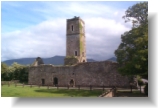
The Archdiocese of Cashel and Emly
¦ History Index ¦
¦ Main Page ¦
Origins
¦ History Index ¦
¦ Main Page ¦
Saint Ailbe

One account tells how Ailbe petitioned King Aengus of Munster on behalf of St Enda, asking him for a site for monastery. Aengus was unaware of the islands in his domain until he dreamt of them and acceded to grant them to Enda. (The ancient connection between the Aran Islands and the region of his kingdom may be discerned in the name Tiobarad Árann)
He founded the monastery of Emly which became very important in Munster. A ninth century Rule bears his name.
And the wolf? Ailbe was able to save the wolf when he was present at a run at which she was to be killed. She ate from his table from then on.
The feast of Saint Ailbe is celebrated in the Archdiocese on 12 September.
¦ History Index ¦
¦ Main Page ¦
Viking Upheaval
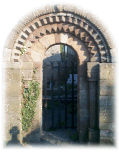
Emly's famous monastic school and the beautiful Derrynaflan Chalice serve to exemplify the remarkable achievement of the monastic church period in the dioceses of Cashel and Emly. The Emly. The Hoard (chalice, paten and wine strainer) was discovered on a Sunday afternoon, 17 February 1980, in the environs of the ancient monastic settlement of Derrynaflan, an island in Littleton Bog, County Tipperary.(List of Monastic Sites)
¦ History Index ¦
¦ Main Page ¦
Medieval Ebb and Flow
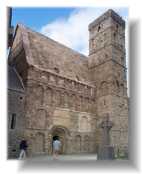
The arrival of the Gregorian reform movement in twelfth-century Ireland hastened the replacement of a predominantly monastic Church structure by a regular diocesan system. Cashel's metropolitan status dates from this period. The reform alsoaccelerated thee introduction into Ireland of numerous new and renewed orders of monks, canons and friars. Both Cashel and Emly had many houses of these Religious throughout the late medieval period.
The beautifully impressive Cormac's Chapel on the Rock of Cashel represents Irish links with medieval Germany. (The background image of this page is of sandstone arcading at Cormac's Chapel). Holycross Abbey, founded in 1180 and restored as a parish church in the 1970's, ranks amongst the famous late medieval Irish Cistercian monasteries.
The initial vitality of this medieval era gave way, in time, to stagnation and decline. However, a promising renewal was gathering momentum during the fifteenth century. Sadly, this renewal was interrupted by the arrival of the Protestant Reformation in the next century.
¦ History Index ¦
¦ Main Page ¦
Reformation, Oppression, Survival
The prominence of Cashel and Emly laity, bishops, priests and religious among the Irish martyrs of the period is testimony to remarkable fidelity in the face of persecution and oppression. The most famous of these martyr's is Blessed Dermot O'Hurley, Archbishop of Cashel, who was subjected to cruel torture before being martyred in Dublin on 20 June 1584. The following were among his final words to the crowds gathered at Hoggin Green,
I am a priest anointed and also a bishop. although unworthy of so sacred dignities, and no cause could they find against me that might in the least degree deserve the pains of death, but merely my function of priesthood wherein they have proceeded against me in all points cruelly contrary to their own laws.
No less inspiring is the example of the victims of massacres in Moor Abbey, Galbally, in 1570 and on the Rock of Cashel in 1647. Martyrs also associated with the diocese are Dominican Terence O'Brien, Franciscan John Kearney and Augustinian William Tirry.
In 1611, there were only two Catholic bishops in Ireland - David Kearney of Cashel and Conor O'Devaney a Franciscan and Bishop of Down and Conor. O'Devaney had been imprisoned in 1588 for four years, he was arrested again in 1611 and executed in 1612.
The significant Irish clerical and lay Diaspora in Europe during these centuries is fittingly represented by Cashel priest, Fr.Theobald Stapleton, whose famous Catechism for use on the Irish mission was composed in Brussels in 1639.
¦ History Index ¦
¦ Main Page ¦
Rebuilding the Edifice
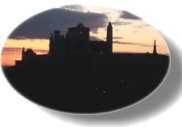
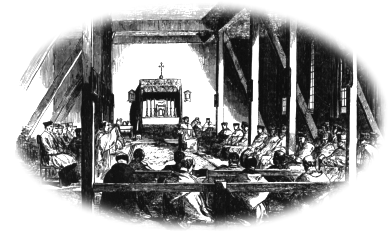 |
The Synod of Thurles was held from 22 Agust to 9 September 1850. This was the first National Synod of the Catholic Church in Ireland after Catholic Emancipation. The synod met in the Chapel of Saint Patrick's College, Thurles.
The era of renewal and consolidation, which now appears to be changing, is also characterised by a remarkable commitment of personnel and resources to the needs of a wider Church. In common with the entire Irish Church, the Archdiocese of Cashel and Emly can be proud of its contribution to the development of Catholicism through the world, notably through the work of St. Patrick's College, Thurles. No less impressive is the work of the many Cashel and Emly missionaries who Severin Africa, Asia and, more recently, South America. The lives and ministry of both Bishop Shanahan in Southern Nigeria and Bishop Thomas Quinlan in China and Korea are fitting testimony to the generosity and courage of the many other missionaries from Cashel and Emly, and the entire Irish Church, during the past century-and-a-half.
|
